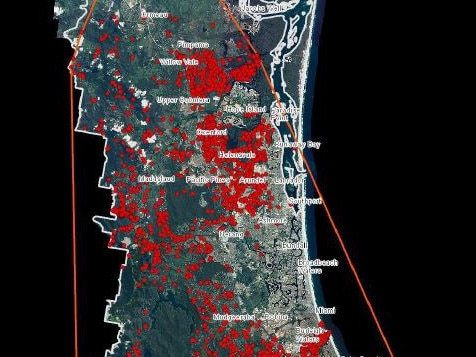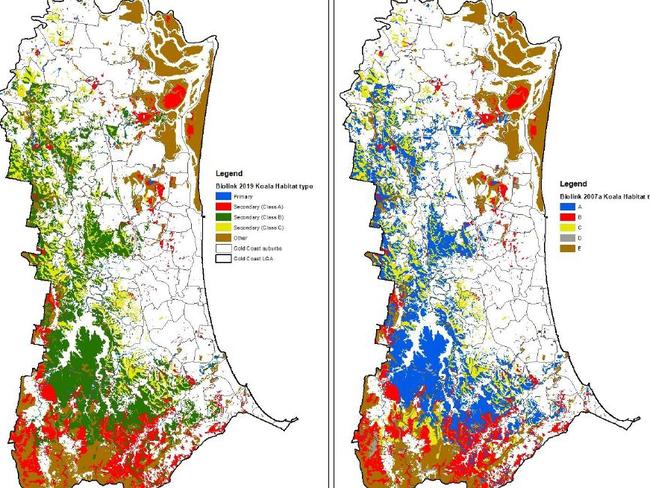Gold Coast koalas: Report reveals Coast lost half its koala habitats
The Gold Coast has lost more than half of its koala habitat — but the species remains widespread, a new report has revealed.

Gold Coast
Don't miss out on the headlines from Gold Coast. Followed categories will be added to My News.
THE Gold Coast has lost more than half of its koala habitat but the species remains widespread and continues to thrive in some areas west of the Pacific Motorway, according to a new report.
Findings in a new report to the city council show a loss of 44,389ha of primary koala habitat – 51 per cent of the cover from when vegetation started being cleared throughout the city.

An estimated 5891 koalas last year were located in 41,291 hectares across the Coast.
About one-fifth of the available habitat had supported koalas across three generations, with consultants finding several areas known for their “generational persistence”.
Healthier and resilient habitats included Lamington-Numinbah-Springbrook in the Hinterland, Tallebudgera-Elanora-Currumbin on the Gold Coast’s southern end, and Burleigh.
In the central Hinterland, Bonogin-Mudgeeraba-Worongary remained koala strongholds, along with Mount Nathan, Wongawallan, Helensvale and Coomera, Cedar Creek and Pimpama.
“There has been a reduction of approximately 20 per cent in the area of available habitat occupied by koalas during 2000 to 2017 – when compared to the 1927-1999 time frame,” the report said.
BEST GOLD COAST SUBURBS TO SPOT KOALAS IN

A councillor welcomed the report because it showed the transfer of koalas under stress at east Coomera to Lower Beechmont and Wongawallen had been a success.
“I was very pleased to hear of the success of the Lower Beechmont koala translocation program,” area councillor Glenn Tozer said.
“Notwithstanding some issues I have with the presentation’s baseline vegetation data, I am confident there will soon be a way forward to see even more vegetation cover across the Hinterland that might include trees and vegetation appealing to koalas, growing their habitat options.”
Cr Tozer agreed the findings were complex because the technology for capturing wildlife and habitat data had changed across decades.
“I am informed that previously, a property on which koala vegetation was located was captured in its entirety as a ‘preferred koala habitat site’, even though a portion of it might have been partially cleared from colonial settlement or farming prior to 2000,” he said.
“One of the processes that has occurred over past years is ‘ground-truthing’ by aerial survey or actual observation and this has resulted in fluctuating data relating to actual vegetation coverage.

“What’s important is that we implement a strategy to improve appropriate koala habitat moving into the future and I’m confident the city’s plan retains that as a key objective in Division 9 and across the broader local government area.”
Major findings from the study showed suburbs with the highest percentage loss of prime koala habitat were Biggera Waters, Bilinga, Broadbeach Waters, Main Beach, Mermaid Beach, Mermaid Waters, Bundall, Surfers Paradise, Robina and Steiglitz.
Suburbs with the greatest land loss of remnant habitat included Mudgeeraba, Upper Coomera, Advancetown and Pimpama.
GET FULL DIGITAL ACCESS: $5 PER MONTH FOR THE FIRST 3 MONTHS

The report by Biolink ecological consultants referred to studies in 2006 that warned three sub-populations east of the Pacific Highway could not be guaranteed a future.
But by 2017, despite a reduction in population, koalas remained widespread at Coomera, Pimpama and Coombabah in the city’s fast growing north.
When suburbs east of the highway were compared with west of the M1, the total loss of koala habitat in the hinterland was far greater.
But consultants found the removal of remnant koala habitat was, “when expressed as a percentage loss”, significantly greater in the east of the M1, reflecting the impact of development on the tourist strip.


